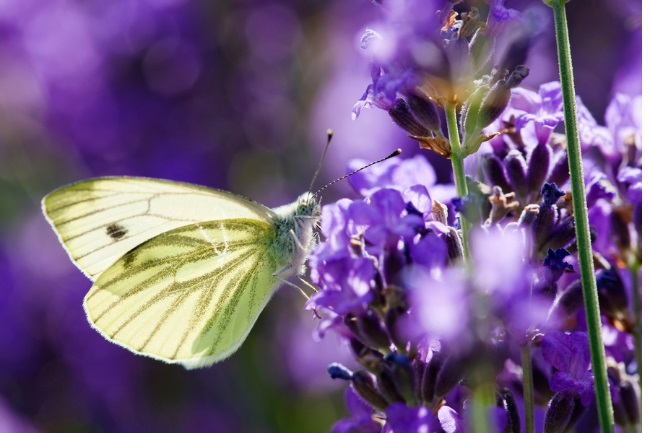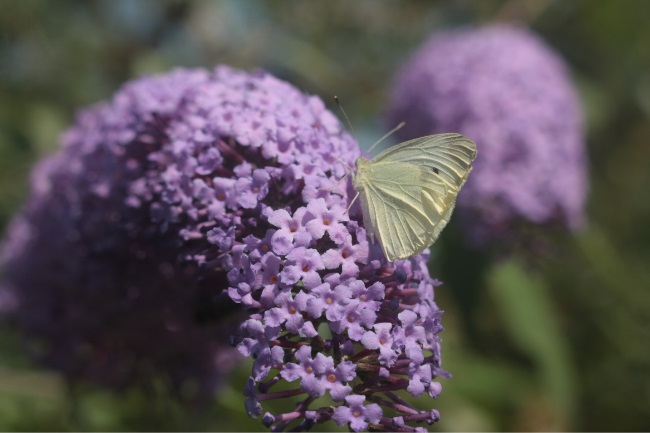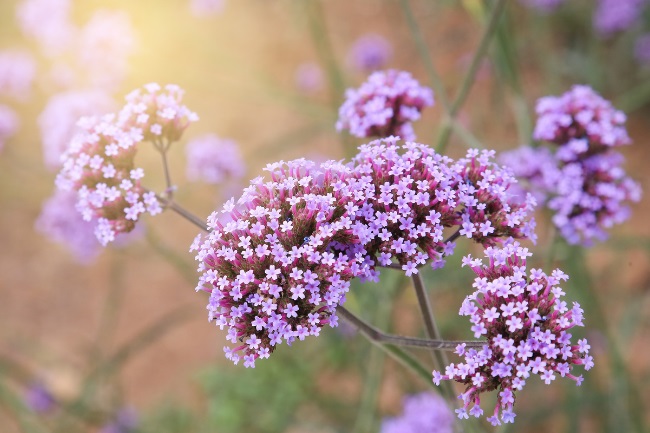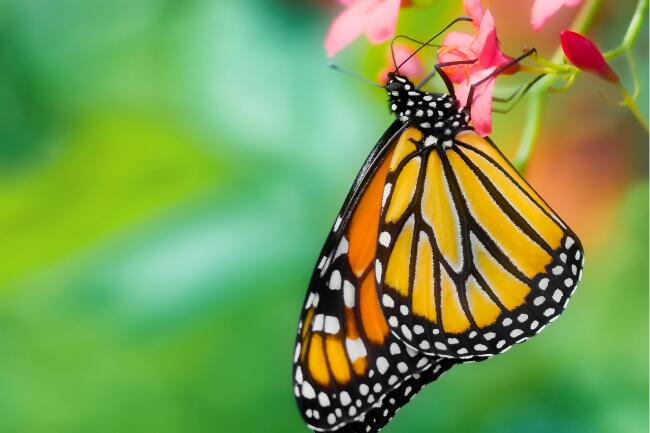There are around 18,000 species of butterfly in the world, and almost all rely on nectar from plants as their main source of food. Which flowers they enjoy depends partly on the species, however, there are many easy butterfly favourites worth celebrating.
Contents
Garden plants

Many garden plants are chosen specifically because they will attract butterflies into your home. These may not be native to the country in which they are being grown but can still provide a veritable buffet for the locals.
Buddleia

Buddleias are attractive garden shrubs, also known as the ‘butterfly bushes’ because of their amazing magnetic appeal to many different species of butterflies. There are around 140 different buddleia species globally, many of which have been cultivated to use as garden plants. Their clustered flowers come in many different colours and shapes and often possess a heady fragrance. One of the most common varieties is known as ‘summer lilac’.
Sedum

Sedums are fleshy-leaved plants that have recently shot to fame in their use in green roofs. With around 400 different species, there are plenty of different varieties to admire. Their five-petalled flowers may be small but they generally cover the plants, creating a colourful carpet. Sedums come in many different forms, with different leaf shapes and a wide variety of flower colours.
Verbena
There are around 150 species of verbena, and many have been very popular in gardens due to their attractive flowers and their benefit to pollinators. Purpletop vervain is one of the most regularly used species due to its brilliant colour and elegant structure. Most species come in blues, purples and pinks.
Lavender

Perhaps one of the most famous garden flowers in the world, lavender is a wonderfully fragrant flower and a member of the mint family. Every part of the plant is scented and has long been used in the creation of soaps, perfumes and even to flavour food. Popular with both bees and butterflies, lavender plants are also used to draw pollinators into other crops, to increase production.
Also read: Here’s How and What Does a Butterfly Eat in The Winter
Native to the UK
Many garden plants are not native to the countries in which they are growing, having been imported and cultivated from elsewhere. While these plants can still support large numbers of native insects, they are unlikely to support as many as native plants.
| Plant Name | Scientific Name | Butterfly Species Attracted |
|---|---|---|
| Common Knapweed | Centaurea nigra | Meadow Brown, Small Skipper, Painted Lady |
| Buddleia | Buddleja davidii | Small Tortoiseshell, Peacock, Red Admiral |
| Foxglove | Digitalis purpurea | Small Pearl-bordered Fritillary, Painted Lady |
| Bird’s-foot Trefoil | Lotus corniculatus | Common Blue, Dingy Skipper, Small Copper |
| Red Campion | Silene dioica | Small Skipper, Peacock, Painted Lady |
Wild marjoram
We may not think of Mediterranean herbs as having a place in our British countryside, yet wild marjoram is found on limestone grasslands across the country. With its green leaves and bunches of soft purple flowers, it is an attractive plant to look at as well as eat. Just like the oregano, it can be used to cook with, but even better its nectar-rich flowers can attract many kinds of butterflies.
Common knapweed
Common knapweed looks similar to a thistle, with its bulbous flowers topped with purple petals. One of the big benefits of this species is that it flowers towards the end of the summer when little else is available. Found in meadows and grasslands across the UK, this tall and dense perennial is easy to spot later in the year, festooned with butterflies and bees.
Field scabious
This pale purple disk-shaped flower has a gentle elegance, perched atop a swaying hairy stem. Traditionally seen adding a splash of colour to native meadows it has also been added into flower borders to mingle with other blooms. It particularly appeals due to its long flowering period and the fact that it blooms in the late summer when many other species are going over.
Hemp agrimony
With its scruffy-looking purple flowers, hemp agrimony may not be the most eye-catching plant, but when bejewelled with many different butterfly species it really is stunning. Often found on the edges of ponds and wetlands, it forms large dense bunches that can provide shelter for many smaller insects too.
Also read: How to Deal with Whiteflies on Plants? (Prevent Damage)
Native to the US

Many wonderful wildflowers exist across the US that supports native butterfly species. From plants that once had their homes in the prairie grasslands to those that grow deep in forest shade, there’s plenty for hungry butterflies to feast upon.
| Plant Name | Scientific Name | Butterfly Species Attracted |
|---|---|---|
| Butterfly Weed | Asclepias tuberosa | Monarch Butterfly, Painted Lady, American Lady |
| Purple Coneflower | Echinacea purpurea | Painted Lady, Eastern Tiger Swallowtail, Black Swallowtail |
| Joe-Pye Weed | Eutrochium purpureum | Tiger Swallowtails, Great Spangled Fritillaries, Red Admiral |
| New England Aster | Symphyotrichum novae- angliae | Monarch Butterfly, Painted Lady, American Lady |
| Swamp Milkweed | Asclepias incarnata | Monarch Butterfly, Painted Lady, American Lady |
Butterfly weed
The attractive orange flowers of the butterfly weed truly look like they were designed to grace the border of a modern garden, however long before their use as an ornamental plant, they grew wild on the American prairies. Known for its ability to draw in butterflies, this plant also has an attractive scent, often described as similar to vanilla.
Buttonbush
With its pale yellow or white spherical flowers, it’s fairly obvious where the buttonbush got its name from. This small shrub not only offers a little structure and leafy foliage, but its flowers are surprisingly delicate and quietly stunning. As well as butterflies the buttonbush can attract other wildlife, such as hummingbirds and other avian visitors to feed on the seeds in the winter.
Joe Pye weed
Though Joe Pye weed may be a relative of the sunflower it centrally doesn’t look anything like its cousin. A tall and dense plant its scruffy-looking purple flowers add a burst of colour into its wetland surroundings. As well as butterflies a number of moths are particularly keen on this plant.
Meadow blazing star
Meadow blazing star really is a stunning plant to behold, with its flower of lilac coloured flowers. Not only is it attractive in itself but it’s a favourite food plant of the monarch butterfly. There’s certainly plenty of flowers to go around, with plants often having more than one flower spike, providing a haze of purple to any setting.
Also read: Butterflies Pollination Explained – What Flowers do They Like?
Feeding the hungry
Sadly many of our wildflowers have seen drastic decreases over the last few decades. Often this is down to changes in how our landscapes are managed, from lawns that are mown more regularly to fields that have been intensified. With less and less in bloom, many butterflies have gone hungry.
While some flowers many attract in more butterflies the fact is the more flowers the better for all kinds of insects. Whether it be planting up your garden with blooms or mowing a little less regularly, there are plenty of ways to put more colour back into our lives.
Also read: Creating a DIY Butterfly Garden (A List of Must-Haves)

